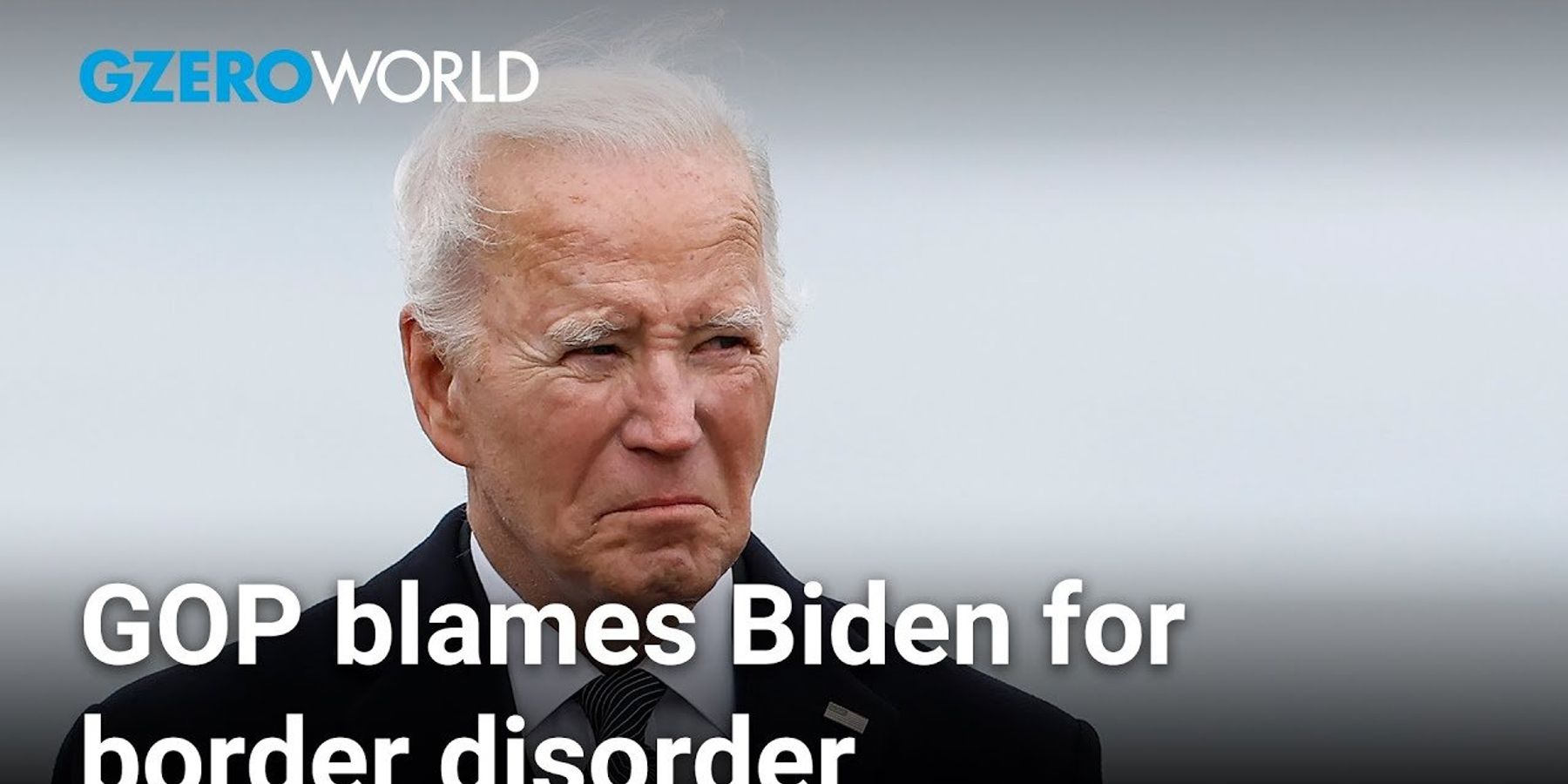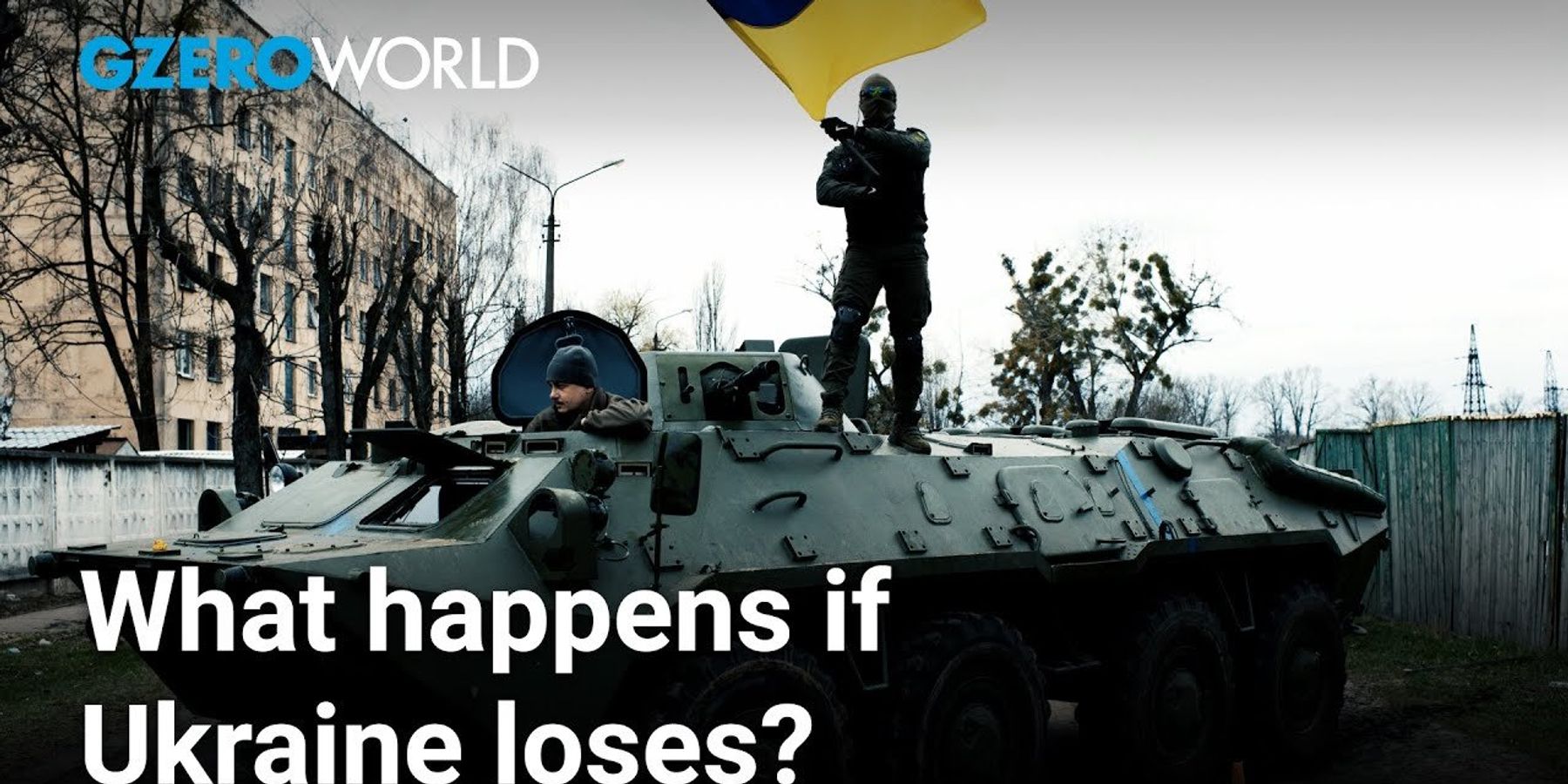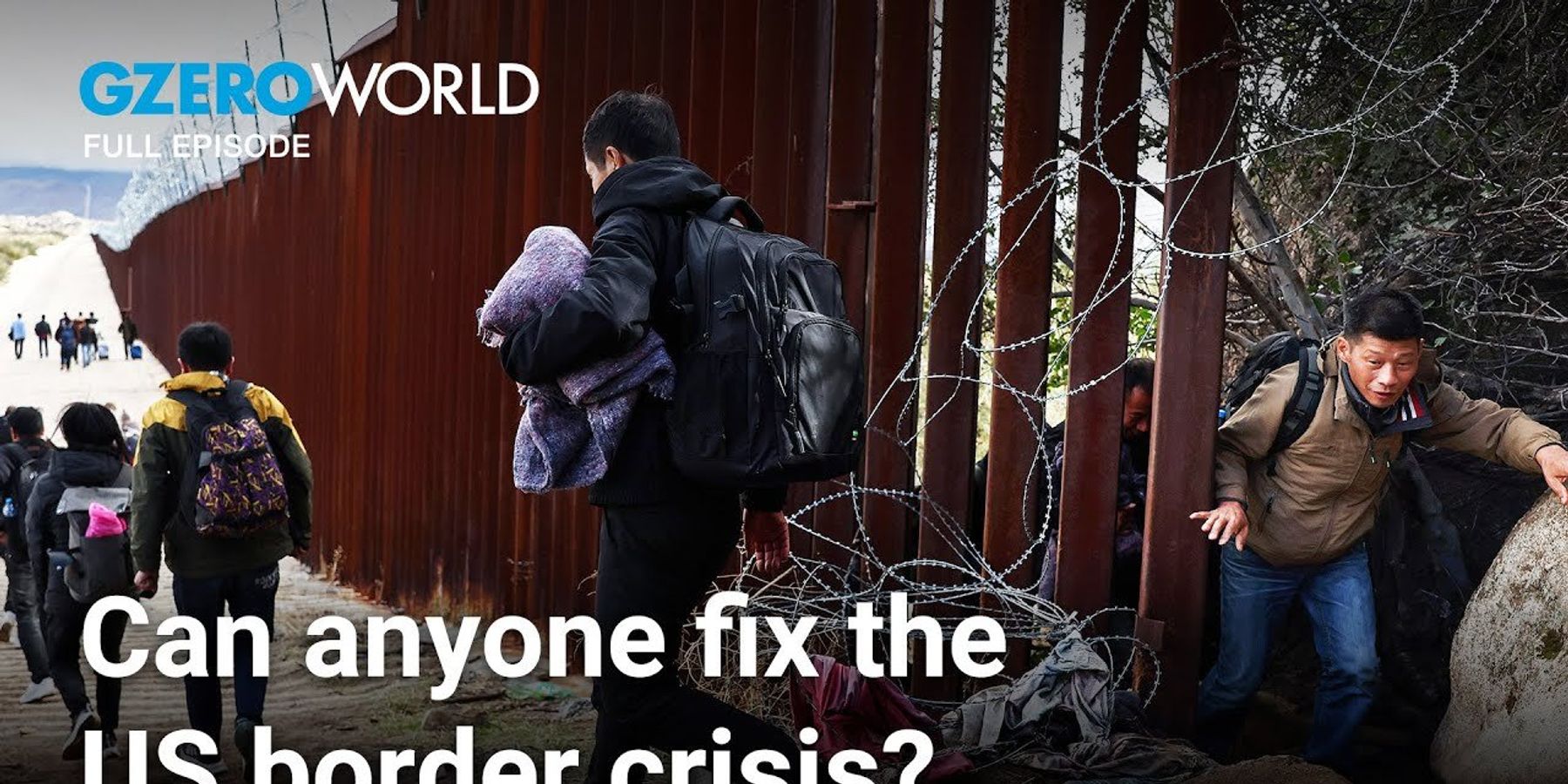Trending Now
We have updated our Privacy Policy and Terms of Use for Eurasia Group and its affiliates, including GZERO Media, to clarify the types of data we collect, how we collect it, how we use data and with whom we share data. By using our website you consent to our Terms and Conditions and Privacy Policy, including the transfer of your personal data to the United States from your country of residence, and our use of cookies described in our Cookie Policy.
{{ subpage.title }}
Swiss Federal President Viola Amherd poses with President Petr Pavel of the Czech Republic and President Volodymyr Zelenskyy of Ukraine during the Summit on Peace in Ukraine, in central Switzerland for the Summit on Peace in Ukraine, on June 15 and 16.
Czech Republic takes a Russian “interest” in Ukraine
The Czech Republic announced Tuesday that it will use the interest accrued on frozen Russian assets to purchase hundreds of thousands more artillery shells for Ukraine.
The back story: When Russia invaded Ukraine in 2022, the EU froze roughly $300 billion worth of Moscow’s assets – mostly bonds and other securities – held in EU banks. Earlier this year, the EU agreed to use interest and other profits from those assets to help support Ukraine. Russia objects to the policy as “theft.” So far, about $1.5 billion is available.
Czech-ing Russia’s invasion. Even before the frozen asset plan, Prague had raised about $1.5 billion in donations from 15 different countries to buy shells for Ukraine. The new influx of ammo will be welcome news but not a game-changer. Kyiv continues to suffer a shortage of shells and has even begun rationing them to keep the current invasion of Kursk well-supplied.
The shadow of the past. It’s no accident that Prague announced this new initiative on Aug. 20. That’s the date in 1968 when Moscow launched a massive invasion of Czechoslovakia to suffocate the Soviet satellite state’s brief experiment with greater freedom of expression, democratic participation, and economic decentralization.
Italian Prime Minister Giorgia Meloni, Japanese Prime Minister Fumio Kishida, Canadian Prime Minister Justin Trudeau, U.S. President Joe Biden, European Commission President Ursula von der Leyen and World Bank President Ajay Banga attend a Partnership for Global Infrastructure and Investment (PGII) event, on the first day of the G7 summit, in Savelletri, Italy, June 13, 2024.
G7 strikes compromise on Ukraine funding
Both Justin Trudeau and Joe Biden flew to Italy this week for G7 meetings, where they pledged to strengthen the coalition supporting Ukraine in its fight against Russian invaders.
The G7 countries are expected to agree to lend Ukraine about $50 billion for reconstruction, backing the loan by using the interest accruing on $300 billion worth of Russian assets that were frozen by Western financial institutions after the invasion.
The move is a grand compromise between countries, like Canada, which have called for outright seizure of those assets in order to give them directly to Ukraine, and countries in Europe, where many of the assets are located, which have pushed back, citing issues of rule of law and precedent for other investors.
Putting the deal in practice will still require some complicated financial and legal chicanery, say experts, but the sense of urgency comes in part from concerns about the US Presidential election this fall.
Polls continue to show Biden, a strong supporter of Ukraine, trailing Donald Trump, who has shown little interest in helping Kyiv.
The asset-interest scheme is seen as a way to lock in a stream of Western financing for Ukraine that exists independently of any changing political winds in Washington.
A broken plate of a splitting a map of Ukraine.
Two years in, there’s no end in sight for the war in Ukraine
It’s been two years since Russia launched its full-scale invasion of Ukraine, starting the deadliest conflict that Europe has seen in decades. And there are no signs that it is anywhere close to ending.
The numbers tell a grim story. By NATO’s best estimates, 70,000 Russians have died and 250,000 have been injured over the course of the war, comprising some 90% of Russia’s pre-war troops. Kyiv is highly secretive about battle losses, but its latest figures put the number of soldiers killed at 31,000 (almost certainly a significant undercount), with hundreds of thousands more injured. Meanwhile, Russia still occupies around a fifth of Ukrainian territory.
After a momentous 2022 where huge chunks of land changed hands, 2023 saw a fairly static line of control, with both sides failing to make decisive gains on the battlefield despite major losses of personnel and equipment. This year promises to look much like the last, with missile and drone strikes on each other’s homeland wreaking economic damage but continued fighting causing little meaningful change to the frontline as the conflict settles into a defensive struggle. Lower levels of Western military aid to Kyiv – especially from the United States – relative to 2022 and 2023 will hinder Ukraine’s ability to retake its land but not its ability to defend itself, despite Russia’s battlefield initiative and material advantage. Both governments’ ability to sustain the war over the coming year makes a cease-fire or negotiated settlement unlikely.
But we are at a turning point in the war’s trajectory. While the Ukrainians remain steadfast in their fight, America’s dysfunctional politics are making a victory for Ukraine look more elusive than ever. Everything now hinges on what happens in Washington in the next few days and weeks, where securing Congressional approval for Ukraine funding has become a much bigger political challenge than anyone expected. And the deeper we get into the presidential race (and the closer Donald Trump is to becoming the official Republican nominee), the less likely it is that Ukraine will receive any additional funding at all until after the November election.
Stalling US aid would put Ukraine’s defense at risk. US military support is vital to helping Ukrainian forces defend against Russian offensive operations and aerial attacks. It is also important for Ukrainian efforts to reconstitute their ability to launch future offensives. While failure to approve new funding would not completely cut Ukraine off from Western arms – it would still get weapons from European governments and from the US over the long run – diminished near-term delivery of artillery, air defense, and other items by the United States would severely limit its ability to maintain the frontline where it is for long, potentially setting the country on a path to defeat as soon as 2025. Where defeat means giving up more territory in Donetsk and possibly Kharkiv oblasts, weakened defenses against Russian missile and drone strikes against Ukrainian cities, and then being forced to accept a much more unfavorable cease-fire or settlement.
US pullback would increase the risk of escalation. Ukrainian leaders are likely to become more risk-acceptant in an environment in which Western governments are not delivering the military aid they need to sustain not just offensive but also defensive operations. That would mean a stepped-up campaign using drones, missiles, and covert operations to hit targets in Russia (including economically significant oil and grain export facilities) as well as Russian military positions in occupied Crimea, risking Russian retaliation. Ukraine’s ability to produce drones domestically means that it would still be able to conduct these kinds of attacks despite diminished Western support. For its part, Russia could see the decline in US aid as an opening to push its advantage, launching more aggressive offensive operations to capitalize on Ukraine’s weakened defenses.
Whether out of a sense of desperation or out of a sense of impunity, diminishing Western support for Kyiv would lead both sides to show less restraint and the conflict to escalate, raising the odds of unintended confrontation between Russia and NATO.
Diplomacy would remain as remote as ever. Opponents of additional US military support claim that cutting off aid to Kyiv would put pressure on President Volodymyr Zelensky to negotiate an end to the war – their stated aim. However, opinion polls in Ukraine show overwhelming support for a continuation of the war even if Western aid falls, with 92% of Ukrainians saying they would accept nothing short of a total Russian withdrawal from their territory including Crimea. Meanwhile, reports suggesting Russian interest in a cease-fire do not indicate any flexibility from President Vladimir Putin about the status of the territories under Russian occupation. Moscow’s insistence that Ukraine recognize those illegally annexed areas as sovereign Russian territory in exchange for peace is a non-starter for Kyiv, just as Kyiv’s insistence that Russia withdraw from all Ukrainian territory including Crimea is a non-starter for Moscow.
If Ukraine faces significant setbacks on the battlefield in the coming months due to reduced US aid, Ukrainian public opinion on territorial concessions could shift, and Zelensky’s calculations about talks may change accordingly. Knowing the Ukrainian people and their will to fight, I rate this as unlikely. But even if it came to pass, diplomacy would still require Russia to come to the table for constructive discussions – something that Putin will have little incentive to do as long as he has the military upper hand, Russia’s economy remains robust, Western support for Kyiv is waning, and Donald Trump has an even shot of winning the US presidential election. Russian dissident Alexei Navalny dying in a Siberian gulag earlier this month is a sign of Putin’s strength and confidence – not something that would happen if he were inclined to sue for peace anytime soon.
In short, cutting US aid to Ukraine wouldn’t bring an end to the war any closer. It would only make it easier for Russia to kill more Ukrainians – and embolden Putin to do the same to Moldovans, Latvians, and Poles in the future. Any suggestion to the contrary is wishful thinking at best, and Russian propaganda at worst.
Why Republicans hold Biden accountable for border problems
President Truman famously had a sign on his Oval Office desk that read: "The buck stops here." Indiana Republican Congresswoman Victoria Spartz believes that truth holds when it comes to President Biden and US immigration dysfunction as well.
"I will lay responsibility on President Biden because he is in charge," Spartz tells Ian Bremmer in an interview for GZERO World. "He's a top executive president. Trump is campaigning to be president, so I'll judge him if he is a president, I think he will likely might be."
Ian interviewed House members on both sides of the political aisle for this episode, and Spartz, a Ukrainian immigrant who supports increased US aid to her home country, is not surprised that the bipartisan border deal could not deliver it.
Watch full episode here: The US border at a tipping point
Catch GZERO World with Ian Bremmer every week online and on US public television. Check local listings.
- Ian Explains: Why Congress can't fix the US border problem ›
- Will Democrats and Republicans head for the border? ›
- Migrant and housing crises hit both sides of border ›
- Hard Numbers: A loss for the GOP in Ohio, Poland beefs up border, shark attacks in Gotham, chips fall well for Dresden, Chinese parents swipe for their kids ›
- Zelensky agrees with GOP on border crisis ›
Feb. 13, 2024; Washington, D.C., USA - Senate Majority Leader Chuck Schumer.
Foreign aid bill passed by Senate faces uphill battle in House
A $95 billion bill including aid for Ukraine, Israel, and Taiwan passed with bipartisan support in the Senate on Tuesday in a 70-29 vote.
This occurred despite strong objections from former President Donald Trump – the likely 2024 GOP presidential nominee and de facto head of the Republican Party.
Trump builds a wall against foreign aid. Trump argues that the US should only offer foreign aid in the form of a loan, and his stance on the legislation could help tank it in the GOP-controlled House.
Schumer the optimist. House Speaker Mike Johnson on Monday pooh-poohed the foreign aid bill because it doesn’t include provisions to boost border security – an issue that’s created a logjam in Congress for months.
But just last week, Republicans killed bipartisan legislation that lumped the issues together after Trump urged them to do so, warning it could help Democrats in the 2024 election.
Despite these obstacles, Majority Leader Chuck Schumer on Tuesday said he’s confident that if Johnson does “the right thing” and brings the bill to the floor, it would pass with bipartisan support. Minority Leader Mitch McConnell also said he hopes Johnson doesn’t block the bill from consideration.
Up to this point, every Ukraine aid vote has received support from at least 73% of the lower chamber.
If Ukraine loses, US troops could be fighting Russians, warns Rep. Zoe Lofgren
It's a reality that many still find hard to imagine: American troops fighting Russian troops in Europe. But according to California Congresswoman and Immigration subcommittee member Zoe Lofgren, it's a reality we may be facing if we don't continue to support Ukraine.
"Just a short time ago I talked to a Republican House member, and we discussed the lack of Ukraine funding and agreed that if we don't do something that Russia will be emboldened" Lofgren tells Ian Bremmer in the latest episode of GZERO World. "And ultimately we will have American troops fighting Russian troops in Europe. That's pretty dire. We all see it. And yet we're not getting the funding necessary. They're running out of ammunition."Whether or not Congress can get its act together in time to help Ukraine is still very much uncertain. But in the meantime, the US/Mexico border will remain dysfunctional, and one of America's closest allies in Europe will keep fighting to maintain its own borders as well.
Watch full episode here: The US border at a tipping point
Catch GZERO World with Ian Bremmer every week online and on US public television. Check local listings.
The US border crisis at a tipping point
How do you solve a problem like the US southern border? If that question makes you hum a certain Sound of Music song, just know that it's more pleasant than whatever has been floating through the minds of the hundreds of members of the US Congress. Because if there was ever a week of dysfunction on Capitol Hill, this was it. Congress failed to advance, or even entertain, a bipartisan US border deal, which also included much-needed funding to Ukraine. Why? Because of a man who is not even in government now, but very well might be back again soon: Former President Donald Trump. To unpack why the border crisis is getting worse instead of better, Ian Bremmer speaks with lawmakers on opposing sides of the aisle in Capitol Hill.
"We have an urgent need for funding for Ukraine," California Democratic Congresswoman Zoe Lofgren says in an interview for GZERO World.. "I mean, urgent...I look at some of my colleagues, and it's like the communist wing of the Republican party. They're ditching Taiwan to China, ditching Ukraine to the Russians. I mean, it's really unbelievable."
Republican Congresswoman and Ukrainian immigrant Victoria Spartz, however, defended why she wouldn't support a border deal in the current form. "I don't think that this piece of legislation really addresses the important issues and strategies that we have to deal with. I don't think it's really addresses in our border situation. It's just kind of lipstick on a pig."
Catch GZERO World with Ian Bremmer every week online and on US public television. Check local listings.
- Texas takes immigration into its own hands ›
- The Graphic Truth: Where immigrants to US & Canada come from ›
- Immigration: A political minefield for Biden and Trudeau ›
- Ian Explains: Why Congress can't fix the US border problem ›
- Biden challenges Texas immigration law ›
- The New York migrant crisis up close - GZERO Media ›
President Volodymyr Zelenskiy of Ukraine is answering questions from journalists during a large summary press conference in Kyiv, Ukraine, on December 19, 2023.
Can Russian money fund Ukraine’s fight?
Washington is leading the charge to confiscate some $300 billion in Russian assets frozen in G7 countries, but some allies in Europe are worried about the legal precedent it would set and how Moscow might retaliate.
Kyiv is facing a funding shortfall as partisan fighting over federal spending in the US leaves money for Ukraine in limbo, while the European Union is struggling to circumvent a Hungarian veto on sending more aid. US Secretary of State Antony Blinken said Washington had dispatched its last aid package under current funding to Ukraine on Wednesday.
The impasse on both sides of the Atlantic has made the notion of using Russian money to fund Ukraine’s fight look tempting, but it is not without risk. There is no clear legal mechanism for taking the assets, and on a larger scale, such a move could spook countries like China, Saudi Arabia and Brazil about the safety of storing their securities in US and European clearing houses. That’s not to mention the pressure Russia might try to impose in retaliation — although recent Russian threats toward Finland, South Korea and Japan have led to nothing.
The US is suggesting the G7 form working groups to address the legal challenges, and the best way to funnel the money to Kyiv. If fully seizing the assets proves too tough to swallow, alternatives like funneling interest earned on the frozen funds to Kyiv could still squeak through. Washington hopes to roll out a plan by the second anniversary of Russia’s invasion on February 24.


